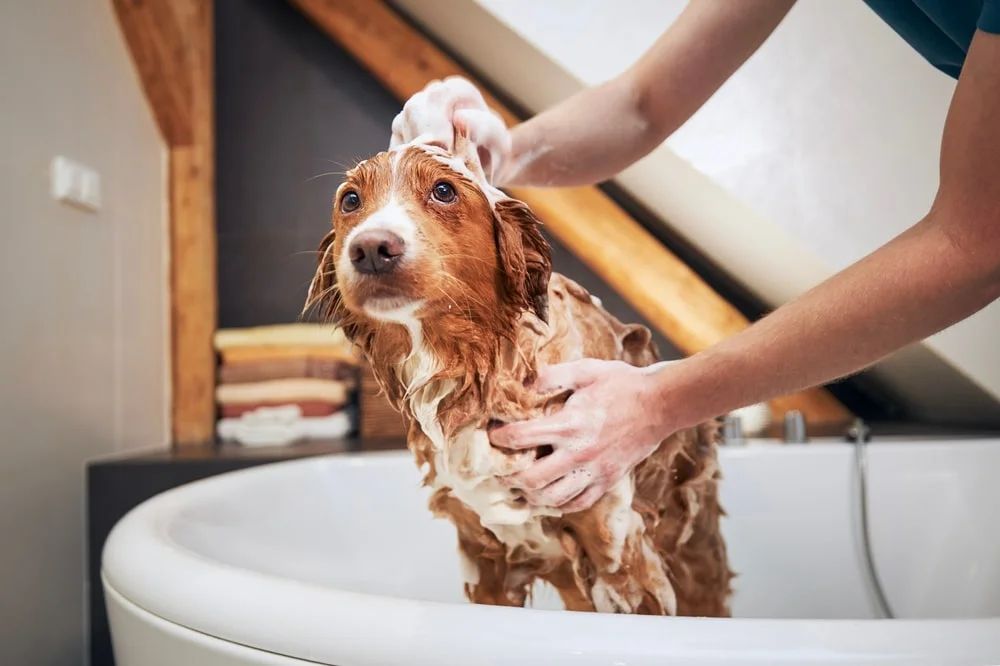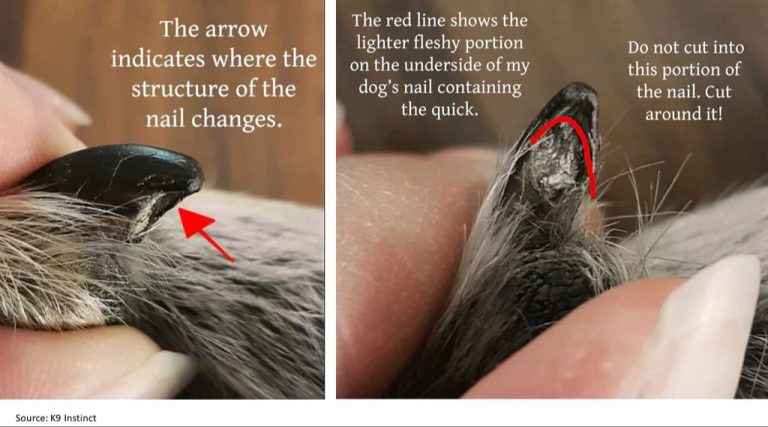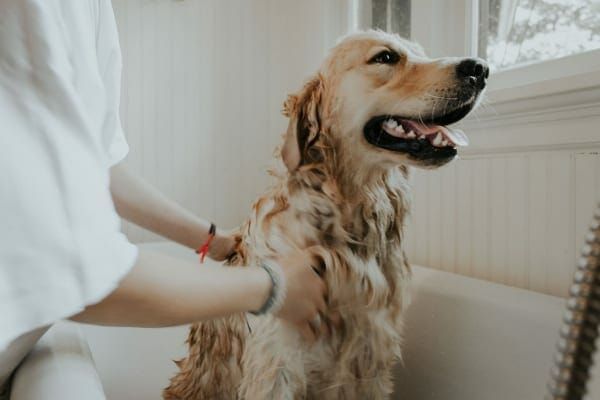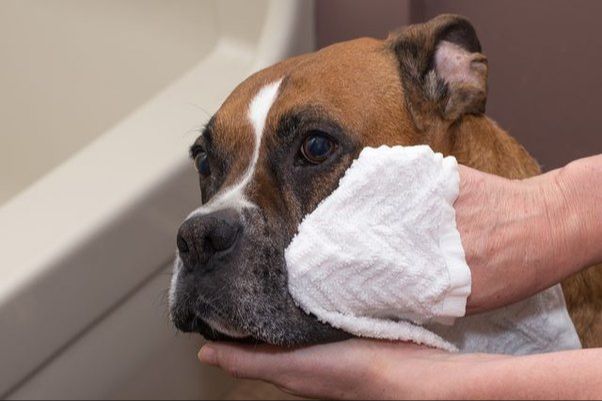Bathing Your Dog: Tips For Success Without The Stress
Why Bathe Your Dog?
Bathing serves several important purposes for dogs. First and foremost, bathing helps remove dirt, debris, parasites, and allergens from your dog’s coat and skin. As dogs play outside and explore their environments, their fur collects pollen, grass, dirt, and other irritants. Regular bathing can remove these substances and prevent skin irritation or allergic reactions. Bathing also eliminates fleas, ticks and mites that may be present on your dog’s skin. Getting rid of these parasites is crucial for your dog’s health and comfort according to Benefits of Bathing Your Dog Regularly. Lastly, bathing helps minimize “doggy odor” caused by the buildup of oils and microorganisms on the skin. By washing away this odor and grime, you keep your dog smelling fresh.
How Often to Bathe
How often you should bathe your dog depends on several factors like breed, lifestyle, length of coat, and skin/coat issues. According to the AKC, “Bathing too frequently can lead to dry, flaky skin so, conversely, not bathing enough can lead to oily coats and pungent doggy odor.” [1]
For most dogs, bathing every 3 months is sufficient unless they get particularly dirty. However, dogs with longer coats like Shih Tzus may only need a bath every 6-8 weeks. Conversely, short-haired dogs that love playing outside like Labs may need monthly baths. If your dog has dry, sensitive skin you’ll want to limit baths to when absolutely necessary. Monitor your dog’s coat and skin health to determine the ideal bathing frequency.
In general, be willing to bathe more often if your dog gets dirty but don’t overdo it. Stick to a schedule that maintains your dog’s skin/coat health. Adjust frequency based on breed coat type, lifestyle and skin sensitivity.
Choosing the Right Shampoo
When choosing a dog shampoo, it’s important to consider your dog’s skin type and any sensitivities. Dogs with dry or sensitive skin may do better with an oatmeal-based or hydrating shampoo formula. Dogs with oily coats often benefit from clarifying or degreasing shampoos. There are also shampoos formulated for dogs with allergies or frequent skin irritations that contain soothing ingredients like aloe, oatmeal, or tea tree oil.
If your dog requires flea, tick or other parasite prevention, look for a shampoo that won’t wash away topical treatments. Some shampoos like Veterinary Formula Clinical Care Antiseptic and Antifungal Shampoo contain insecticides to kill parasites while bathing.
Always read reviews and product details carefully to match your dog’s coat and skin needs. It may take some trial and error to find the ideal shampoo. Avoid shampoos with harsh detergents or chemicals if your dog has sensitivities. A veterinarian can provide personalized recommendations if your dog has recurring skin issues.
Bathing Equipment
Having the proper bathing equipment can make the process much easier and less stressful for both you and your dog. Some key items to have on hand include:
Tub – Options include a regular bathtub fitted with a non-slip mat, a walk-in shower, or a specialized dog bathing tub. Look for tubs with a spray hose attachment and raised edges to contain splashing and mess. Consider your dog’s size when selecting a tub. This tub offers a good adjustable and foldable option.
Sprayer – A handheld sprayer allows you to thoroughly wet and rinse your dog’s coat. Look for adjustable spray patterns and pressure. Attach to tub faucet or use a portable model. Offers various sprayer choices.
Towels – Have several absorbent towels on hand to dry your dog after the bath. Opt for towels specifically designed for pets with extra absorption capacity. Consider towel wraps or robes to keep your dog contained while drying.
Apron – Wear a water-resistant apron to keep your clothes dry during the bathing process.
Gloves – Optional rubber gloves protect your hands and improve grip while bathing a slippery, soapy dog.
Preparing the Bath Space
Before bathing your dog, make sure the bath space is ready. Start by choosing a location with a non-slip surface like a bathtub or utility sink. Lay down a non-slip bath mat or towel on the bottom to help provide secure footing. The room should be warm, ideally around 75-80°F, so your dog doesn’t get chilly during the bath. Make sure to securely attach your dog’s leash to something sturdy, like a bath grab bar. This will prevent them from jumping out of the tub or sink. You may want to place cotton balls in their ears to keep water out. Finally, gather all your bath supplies in one place so they are ready to go.
Source: https://www.purina.co.uk/articles/dogs/health/daily-care/how-to-bathe-your-dog
Bathing Step-by-Step

When bathing your dog, be sure to follow these key steps:
- Wet your dog’s coat thoroughly with lukewarm water. Make sure to saturate the entire coat, getting down to the skin. Check that the water is a comfortable temperature – not too hot or cold. According to Elanco, lukewarm water is ideal.
- Apply a dog-formulated shampoo and work up a good lather. Pay special attention to dirty areas like paws, underbelly, and rear. According to Chewy, start lathering from the tail area up towards the ears.
- Rinse thoroughly to remove all traces of shampoo. You may need to rinse several times. Avoid getting shampoo in your dog’s eyes. Rinsing well prevents skin irritation.
Following these bathing steps helps ensure you effectively clean your dog’s coat while keeping the experience calm and stress-free.
Drying Your Dog
After a bath, it’s important to dry your dog thoroughly to avoid odor-causing bacteria from developing in the damp fur. There are a few methods you can use to dry your dog effectively after bathing:
Towel Drying: Start by gently squeezing excess water out of the coat. Wrap your dog in a highly absorbent towel designed for dogs and pat dry the coat. Avoid rubbing vigorously, which can tangle the fur. Use multiple towels if needed for a large dog. Allow your dog to shake periodically during the process.
Air Drying: You can allow your dog to air dry naturally if the weather is warm. Make sure to thoroughly towel dry first. Let your dog relax comfortably in a well-ventilated area. Air drying can take several hours depending on your dog’s coat length.
Blow Drying on Low: Use a blow dryer on the coolest setting and low speed to gently dry your dog’s coat. Hold it at least 6 inches from the skin to avoid burning. Work in sections using a brush to control the air flow and straighten the hairs. Focus on the harder to dry areas like the armpits first. See Dog Lovers Towel for more blow drying tips.
Brushing & Combing
Brushing and combing your dog’s coat after a bath is an important step that serves multiple purposes. First, brushing helps distribute the dog’s natural oils throughout their fur to keep it soft and shiny [1]. Your dog’s skin produces these oils to help protect their coat, so brushing spreads the oils out instead of letting them pool on the skin’s surface.
Brushing also helps prevent matting by detangling any knots or tangles in your dog’s fur [2]. Matted fur occurs when loose undercoat gets trapped in the topcoat and forms tight clumps or mats. These mats tug at the skin and can be painful for your dog. Regular brushing after baths smooths out the fur and prevents these painful mats from forming.
Always use a brush designed for your dog’s specific coat type. Slicker brushes work well for short-haired dogs, while long-haired dogs benefit more from bristle or pin brushes. Be gentle as you brush and don’t force the brush through major tangles. Brushing should be a relaxing, soothing experience for both you and your dog.
Ear Care
It’s important to properly clean and dry your dog’s ears after bathing to prevent infection. Water left in the ear canal can allow bacteria and yeast to grow, leading to painful infections (Source).
After bathing, gently wipe out the inside of your dog’s ears with a cotton ball or soft cloth to absorb excess moisture. Be sure to only clean the areas you can see, and don’t insert anything into the ear canal. Repeat this drying process 2-3 times for each ear.
You can apply a small amount of veterinarian-recommended ear cleaning solution to help remove water and debris. Use solutions made specifically for dog ears and follow package directions. Never use cotton swabs, which can damage the ear canal.
Check your dog’s ears regularly for signs of infection like odor, discharge, swelling, scratching, head shaking, or redness. See your veterinarian if you notice any of these symptoms after bathing or swimming. With proper care, you can help keep your dog’s ears clean, dry, and healthy.
Providing Positive Reinforcement
An important part of making bath time a more positive experience for your dog is providing positive reinforcement. This means rewarding your dog with treats, praise, and affection during the bathing process. Some tips for positive reinforcement include:
Have tasty treats on hand to give your dog throughout the bath. Small soft treats or pieces of hot dog work well. Reward your dog when he first gets into the tub, while you’re shampooing, rinsing, and drying. This helps create a positive association with bath time.
Offer calm verbal praise like “good boy!” and “that’s a good dog!” in a soothing tone of voice. Pet your dog gently and avoid overly excited praise that could rile him up.
Remain patient and keep the experience as calm and stress-free as possible. If your dog is nervous, go slowly and don’t force him. Taking a patient approach will help your dog relax.
Doing these things helps turn bath time into a more enjoyable experience that your dog will come to appreciate rather than fear. With positive reinforcement, you can make bathing easy and even fun for both you and your dog.





